NEWS and Blog
Nov. 19, 2013 | Posted in Reports, Painting and Drawing, Restoration of Paintings | Tags:
Staff Blog≫ Painting Restoration Course: Gilding Nov.14, 2013
Today’s lesson is about gilding technique. One student is taking yearlong course, so she is doing detailed work on the preparation of the second layer. The other student is taking a 2-month course, so she had completed the preparation of the base.
First, apply a base to the frame to be restored (frame for practice). The first layer of the base is prepared with glue (colla di coniglio) mixed with hydroxide calcium. The second layer is prepared with glue (colla di coniglio) mixed with bolus (usually yellow or red). Yellow bolus gives a natural touch to the restoration even when the gilding falls off, or intentionally gives
Frame for practice with the first layer of the base.
Second layer above the first.
Whether or not this second layer is applied good will affect the next process of polishing.
When the second layer is dry, apply the gold foil and polish using agate stone (Pietra d’agata). The teacher advices students to beware that there are cheap fake polishers, as agate stone is usually costly.
The technique is the same for silver or other foils.
When you cut the gold foil, you need to use a special knife for gold foil, and cut it on a special cushion for guilding (cuscino per doratura).
Apply water glue (colle acqua) with a blush, and place carefully the gold foils cut in square pieces. For practice, we used foil very similar to gold.
Polishing with agate stone.
One student already proceeds to practice applying actual gold foil. The instructor explains about the polishing process.
Put the gold foil and press it with cotton.
Student taking notes of the instructor’s explanation.
The object looking like a pen with black handle is the polisher.
There is also a method to polish the base first and then pu gold foil.













